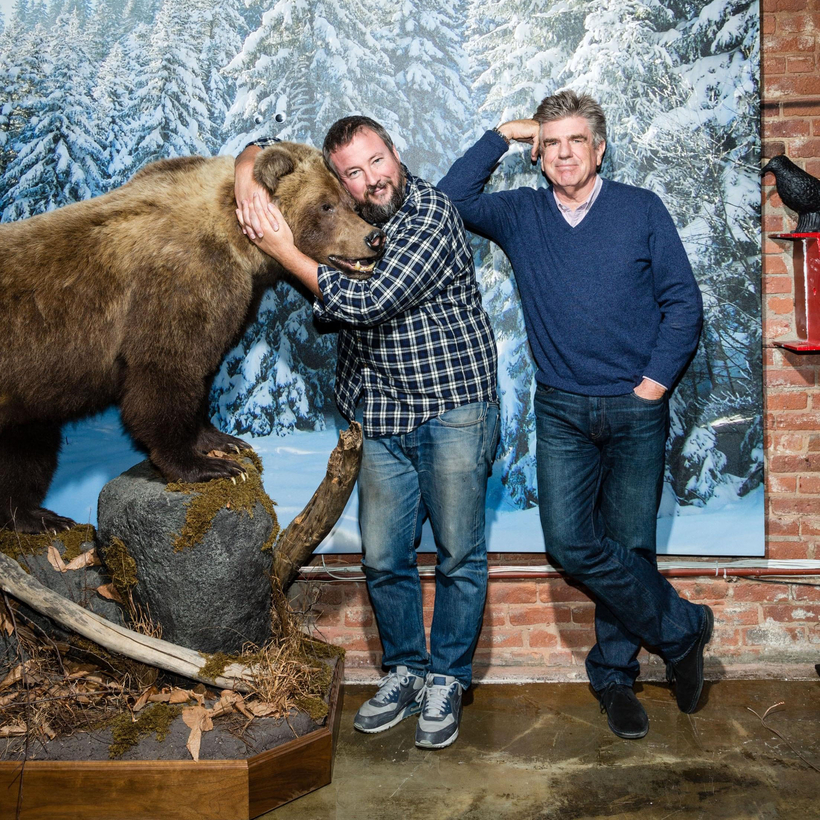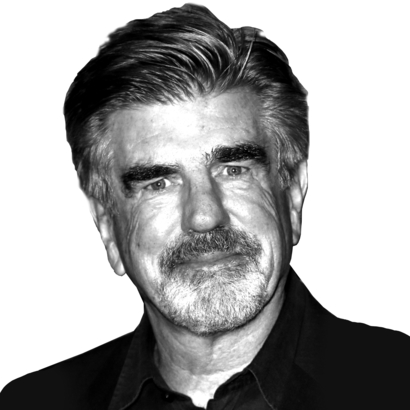It was December 2010, and I was in Brooklyn. Shane Smith waved his hand, motioning me to his table in the Hotel Delmano, a low-lit hipster saloon in Williamsburg. Three shots of tequila were arranged in front of an empty seat. “Say hello to your three little friends,” Shane announced. “Drink those, and we’ll talk.”
Shane, the 41-year-old cofounder and C.E.O. of Vice, wanted to rekindle our relationship. A bear-sized man with extensive tattoos across his torso and up and down his legs, a salt-and-pepper beard, and stringy long dark hair swept back over his red Irish face, Shane was complicated … a punk, a showman, a shaman, a sweetheart, a blowhard, an intellectual of weird shit, and a family man. He was also a man of large appetites, which sometimes got the best of him.
Invariably charismatic, he had assembled a small cult of bearded young men around him, who wore the coveted twenty-four-karat vice gold ring on their fingers. They had convinced each other that they were going to turn Vice into the next big media player. One of these men was Eddy Moretti, Shane’s “creative director.” Like Shane, Eddy was Canadian, a sweet, wiry hipster who looked like Vladimir Lenin with a black fedora cocked on his head.
I met these two characters in April 2006, when I was C.E.O. of Viacom, which owned MTV. Spike Jonze, the film director, had arranged the meeting. Spike had a great eye for odd talent. Years earlier, he introduced Johnny Knoxville to MTV. Johnny became the nucleus of MTV’s Jackass crew, a very successful physical comedy series that spawned several hit movies.
Shane and Eddy ran Vice magazine, an edgy cultural monthly that originated in Montreal and gave away a million-plus free copies every month in boutiques, head shops, and skateboard stores in more than 20 countries. Vice began as Voice—“The Voice of Montreal”—and mostly covered the Canadian music scene. Soon, they dropped the “O” and pivoted to articles like “The Vice Guide to Shagging Muslims” and hired prostitutes to write sex-advice columns. They moved to New York in the late nineties, a boom time for edgy media. (One of their original Canadian partners, Gavin McInnes, would soon part ways and descend into some far-right rabbit holes, eventually starting the neo-fascist Proud Boys in 2016.)

Shane and Eddy wanted to start a digital project with MTV, but had the impression that MTV was “scared of them.” Spike thought a meeting with me could break the logjam. Shane and Eddy strolled into my fifty second-floor office smiling and looking nervous. I had them sit on the couch. Spike described Shane as a “poor man’s Hemingway,” a curious and audacious adventurer. Vice, he said, was going everywhere in search of new and unusual stuff … smart and stupid. They were “the truffle pig of cool.”
Shane would turn out to be one of the greatest salespeople I’d ever meet, maybe the greatest bullshitter, too, but bullshit and all, he was charming. From the edge of the couch, Shane pitched me: they were proven storytellers, the world was in turmoil, they were in all the hot spots, and they could produce quality video inexpensively. Eddy pulled out a DVD and flipped it on my coffee table like it was the ace of spades: The Vice Guide to Travel. The cover was a photo of a completely tricked-out jingle truck from Afghanistan. Maybe they had studied my history and knew about my days in Kabul. Maybe it was serendipity. Either way, it worked.

I popped the disc into my DVD player. There were three or four segments. First was a silly but mesmerizing report on Shane hunting down “radioactive wild boars” with an automatic rifle in the “forbidden zone” around Chernobyl, the doomed nuclear reactor in Ukraine. He seemed inebriated, shooting while holding a drink in the irradiated landscape. Between drinking and shooting, he also seemed to be hitting on his rifle-toting female companion, who, he said, worked with him. Next came a segment featuring pygmies in the Congo. The elevator pitch might have been “programming by drunks to amuse stoners.”
The next segment featured Shane’s partner Suroosh Alvi in Darra, an infamous little burg on the lawless Afghan-Pakistan border. I’d been to Darra decades earlier. Back then, bricks of hashish with gold stamps on them and baggies of opium, as well as an arsenal of guns sat in shop windows. Darra’s claim to fame was “bespoke firearms,” made by Pashtun gunsmiths who could duplicate any gun: AK-47s, German Lugers, and old British rifles. Need a grenade launcher? Darra was the place. On the screen Suroosh, wearing a flat Afghan pakol hat and a flak jacket, popped up and started firing an AK-47, looking like an al-Qaeda jihadi.
I was impressed. Odd for sure, but each segment was framed with a wry, comic presentation. Edited in a lo-fi way with a reportorial voice and style, they had a wacko authenticity. Nobody was doing anything like this, making gonzo stories in faraway places on low budgets. Vice presented itself as a daring guerrilla operation with a sense of humor—the bastard sons of Hunter S. Thompson. “I want to be the next MTV,” said Shane. “I want to conquer the world.”
The scent of bullshit was rolling in, but no one else was coming into my office saying that. MTV folks seemed incapable of producing anything for low prices anymore. Some of them had agents. They were making shows like My Super Sweet 16 and Laguna Beach. It was no wonder they had resisted these wild bozos. Maybe I needed to bring in an outside rebel unit. YouTube had just launched. Shane saw that as the opportunity of a lifetime. Someone had to make good content for it. He insisted that internet video would transform Vice into a global powerhouse. Vice would move the young international audience that already loved the magazine onto digital platforms and would expand their numbers by multiples.
“What else have you got?” I asked. “Nothing,” said Shane. “That’s the only video we’ve done.” “One video? That’s it?” “Yeah, but we’re onto something big and we want to make more. MTV and Vice would be a perfect fit.” Shane was hitting a nerve. MTV had come up against multiple brick walls in our attempts to join the digital world. Perhaps these guys could be a good low-cost online video source. We ultimately agreed to a joint venture, VICE Broadcast Services, or VBS.tv, separate from Vice’s magazine business. We’d be 50-50 partners. Five months later I got fired, was replaced as C.E.O. by Sumner Redstone’s estate attorney, Philippe Dauman, and took off for Burma, Oprah, and Afghanistan.
Four years after that, I got an e-mail out of the blue from Shane: “My beautiful baby boy. When are we loving again. Drinkie??” Curious, I headed to Brooklyn. After I guzzled down my “three little friends,” we got to business. “Philippe Dauman is a nasty stiff,” said Shane. “He didn’t get us, so I just bought the fucker out.” “How’d you pull that off?” “I made myself out to be more trouble than I was worth to him,” Shane replied. “Ahh, the Fish Called Wanda strategy we call that. It can be effective.” Shane had bought back MTV’s half of VBS for a mere $3 million and he was now a free man in Brooklyn.
By the time we met in Williamsburg, Shane had more than delivered on his vision. Vice had evolved into accomplished video storytellers. They had a hot website, a growing library of videos, and a suite of YouTube channels that racked up millions of views with the weirdest shit you could imagine. Shane had become the face of Vice, a tattooed hipster Walter Cronkite. Eddy chimed in, “We made a movie, too, Heavy Metal in Baghdad, about the music scene in wartime Iraq. It premiered at the Toronto Film Festival. We have other films in development, too, dude.”
We went to dinner at another neighborhood spot, where Shane and Eddy were greeted like heroes. Vice, they told me, was the largest employer in Williamsburg. Shane immediately ordered extremely expensive wine, a recurring theme when he dined. Then he made his new pitch: “Join us, Tommy boy. Get richer! How about making millions? We are hot and need some heft. Got to raise some money and take this thing to outer space.” I was skeptical, but Shane plowed on. “You know everyone. You can help introduce us and connect us. You could help us raise money. You can be a consultant. I’m setting up a board. You can be on it. I’ll give you a piece of the company. It’s all right up your alley.”
He wasn’t wrong. I had once run a very hungry, very young creative company full of hustlers. These Vice guys were talented, but I was wary of being an adviser or consultant. I could also see that Shane was a mercurial dude. Vice might just explode.
“Are you ready for the big show now, Tommy Gun?” Shane asked. They pushed me into a black car and we rocketed over the Manhattan Bridge to the Box, an infamous downtown club known for wild, sexy burlesque shows. When we arrived, you would have thought the president of the United States had pulled up. Shane and Eddy were underground celebrities. Doormen came out to meet us, then strong-armed us through the scrum to a ringside table just below the stage. A three-foot-tall bottle of Grey Goose and an ice bucket awaited us. A naked man in a dog collar was being led around by a dominatrix. She rammed a plug up his butt with a poodle tail attached. He wagged it. The crowd went wild. I leaned over and told them, “I love show business.” That was the opening night of my 10-year journey with Vice.
They were shaky, a bit mad, and poorly organized, but they were fun and filling the gap in the market with something new and brash. There was a bit of the early MTV mayhem, the sky’s-the-limit feeling with a crusader energy about them. I signed up and helped them secure an HBO deal that took them into the stratosphere. They would burn bright, but then fell back to earth.
Tom Freston is a media-and-entertainment executive, a co-founder of MTV, and the board chair of the ONE Campaign, an anti-poverty organization


